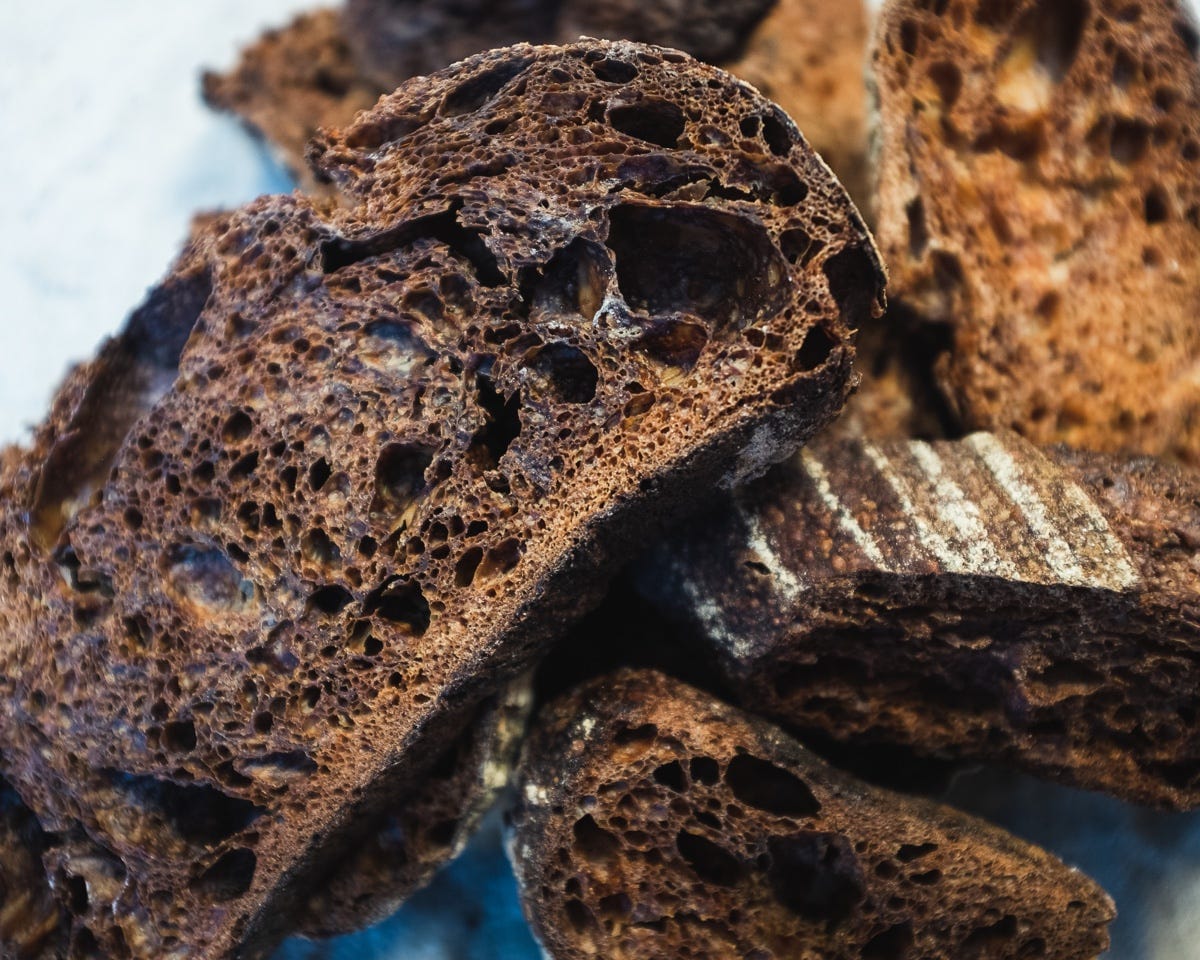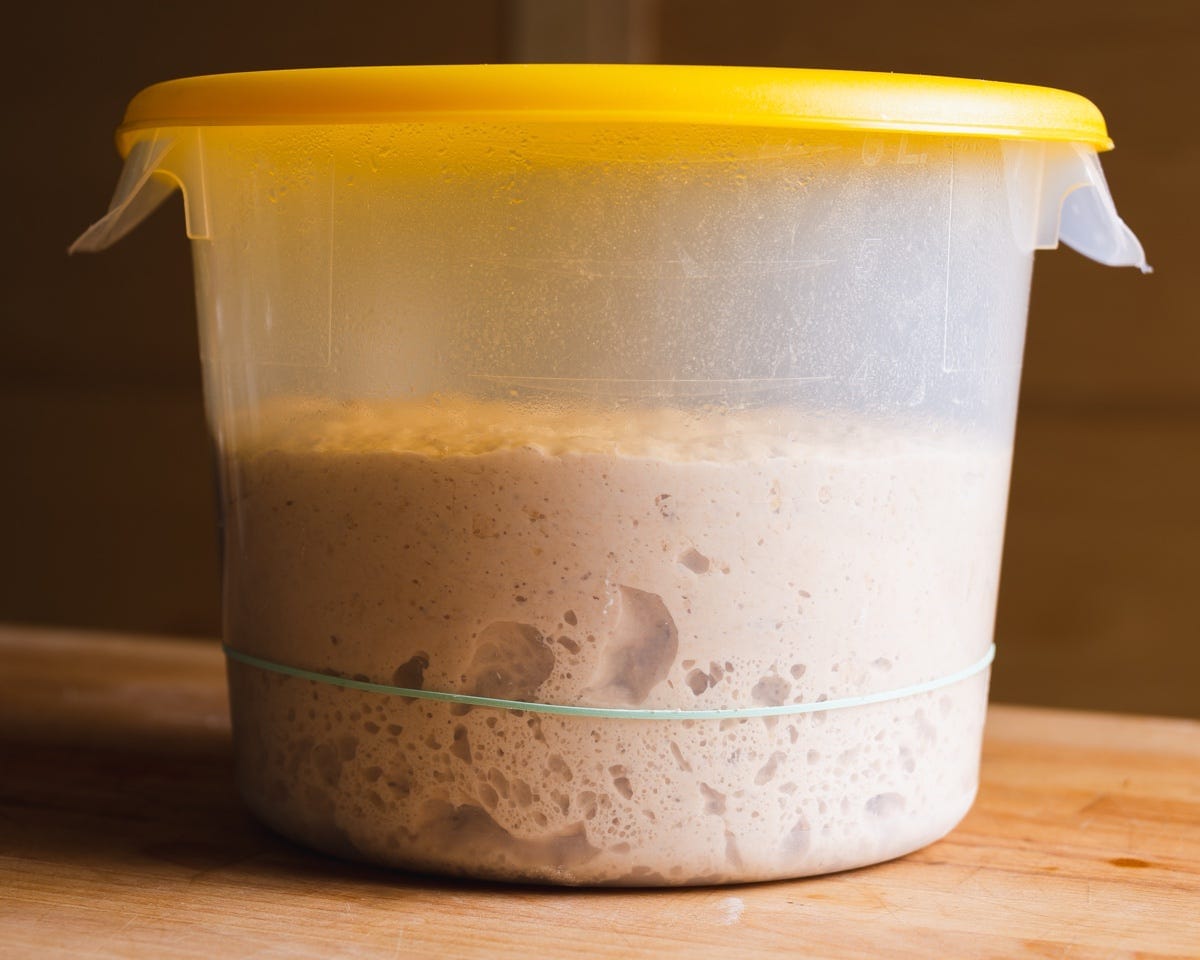Recipe: Burned Bread Bread

I’ve got a new recipe for you all, for the “black” bread I mentioned awhile back on my instagram feed. It’s a great use for old bread—not only is this another great use for leftovers from previous loaves, the old bread acts exactly like a porridge or tangzhong to give the bread a soft texture and to slow down staling. In German baking, this is what is known as an altus, and it is a common element in many rye breads (I talk a bit about it in my King Arthur Night Moves Bread story).
Many altuses (alti?) start by deeply toasting the bread, which lends the bread a dark color and a caramelized flavor. (It’s also, incidentally, an excellent way to preserve old bread for later use—I’m convinced that bread that has been toasted dark and stored in a sealed container is much slower to oxidize and take on a rancid odor than bread that is simply dry. Maybe it is because it is entirely devoid of moisture.) I explain how to make the blackened bread in the notes below.
To further enhance the color and flavor here, I also rehydrate the bread in coffee or espresso, rather than boiling water. Make sure your coffee is at near-boiling temperature when you make the soaker, to ensure the bread hydrates fully.
By the way, I’m testing out a new way to share printable/clean versions of recipes with you all. Rather than a link to a PDF, I’m using an app called Craft to create online versions of documents. The advantage to doing so is that I can make edits to the documents on my computer and they’ll automatically be updated online. And anyone viewing the document can add comments to it. So if you notice anything off or in need of more information, please let me know (here or there, whichever you like). You should be able to easily the document as a PDF or print out a hard copy from your browser. If this method works for you all, I plan to update all the previous recipes with similar documents.
I’ve also added a timeline to the recipe, which should make it more clear how long it will take and how long each individual step should take. Again, I plan to update previous recipes with something along these lines.
Here’s the link to the doc for this recipe: Burned Bread Bread
—Andrew
Notes:
- This method takes about 14 hours before the loaf goes into the fridge, so you’ll want to start in the evening or very early in the morning. Here’s a timeline (listed times show the minimum duration of each stage, while the parenthetical shows the duration or range of time until the next stage):
0:00 - Make burned bread soaker (20m)
0:20 - Mix dough without salt (autoyse) (30m)
0:50 - add salt (30m)
1:20 - coil fold (12 to 16h, until about doubled)
13:20 - preshape (30m)
13:50 - final shape (30m)
14:20 - transfer to fridge (8 to 16h)
22:20 - bake
- To make the burned bread: slice stale bread into ~3/4-inch thick slices. Place in a single layer on a cooling rack set into a rimmed baking sheet. Bake in a 300˚F oven, flipping the slices regularly, until they are just shy of black, 30 to 60 minutes.

Any bread flour will work here, but my go-to supermarket “bread" flour is King Arthur all-purpose flour, with 11.9% protein.
To avoid overproofing, it is important to shape the loaf within an hour or so after the dough is ripe (i.e., when the it is "domed, lightly bubbly, and about doubled in volume"), especially when ambient temps are high. (In the winter, you'll have way more wiggle room.)
If possible, use a transparent container for proofing the dough, it will make knowing when it is ready to be shaped obvious (you will see a fine web of bubbles on the interior of the dough), like this:

- You can use mature levain/sourdough starter that has been refreshed within the previous 10 days; since the recipe uses such a small amount, the exact hydration of the levain is not important here.
- If possible, proof the dough somewhere where ambient temperatures are around 75˚F.
- If that's not possible and temperatures are very cold (below 68˚F), increase the amount of levain to 10%, or 40 grams.
- If ambient temperatures are higher than 80˚F (as in the summer), reduce the amount of levain to 1%, or 5 grams (about 2 teaspoons). And don't let the dough go too long after it's fully ripened.
- The loaf is baked cold, directly from the fridge.
Burned Bread Sourdough Bread
Makes 1 900g loaf
Overall Formula
100% bread flour
83% water / coffee
15% blackened bread
2.2% salt
5% 100% hydration levain/2.5% pre-fermented flour
Burned Bread Soaker (Altus)
130g very hot coffee/espresso
65g blackened bread, broken up into chunks
Final Formula
422g bread flour
220g cool water, 75˚F
22g 100% hydration levain
195g bread soaker (from above)
9g salt
- FOR THE SOAKER: Place bread in medium bowl, and cover with coffee. Cover bowl with plate and let sit for 20 minutes.
- FOR THE DOUGH: Mash soaker with potato masher or balloon whisk until coarse but even paste forms. Place about 15 grams (1 tablespoon) water in a small bowl and set aside. Add remaining water and levain to soaker mixture, and stir with wooden spoon or dough whisk until combined. Add flour and stir with wooden spoon or dough whisk until uniform and no dry flour remains. Add salt and reserved water to top of dough. Cover bowl and let sit for 30 minutes.
- Using hands, knead, mash and squeeze dough in bowl until water and salt are fully incorporated and dough is uniform in texture, 30 seconds to 2 minutes.
- Cover bowl well and let sit for 30 minutes.
- Using lightly-moistened hands, fold dough in bowl until tight and uniform, 6 to 8 folds.
- Desired dough temperature: 75˚F.
- Transfer to proofing container if desired, cover, and let ferment ferment at room temperature (68 to 75˚F) until dough is domed, lightly bubbly, and about doubled in volume, 12 to 14 hours.
- Dust top of dough lightly with flour, loosen from bottom of bowl, and invert onto floured countertop. Using flour on hands and top of dough as necessary to prevent sticking, gently press dough into 8-inch circle, then fold edges toward middle to form round.
- Cover with inverted bowl and let rest for 30 minutes.
- Flour top of dough and surrounding countertop. Using bench scraper, loosen dough from counter. Shape as desired.
- Transfer to floured banneton or lined basket. Cover and let sit for 30 minutes, then transfer to refrigerator for 8 to 24 hours (loaf will not rise appreciably during this time).
- One hour before baking bread, adjust oven rack to middle position, set covered heavy-bottomed Dutch oven on rack, and heat oven to 475 degrees.
- Lay 12- by 12-inch sheet of parchment paper on counter. Remove loaf from fridge and invert onto center of parchment paper.
- Score loaf as desired. Pick up loaf by lifting parchment edges and lower into Dutch oven. Carefully cover pot and transfer to oven. Bake until fully sprung, about 20 minutes.
- Carefully remove pot from oven. Reduce oven temperature to 425. Remove loaf, transfer to bare oven rack, and continue to bake until deep golden brown, 10 to 20 minutes longer. Transfer loaf to cooling rack and allow to cool for at least two hours before serving.





Member discussion